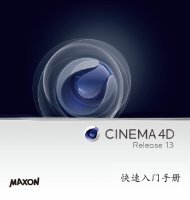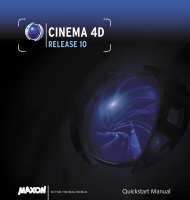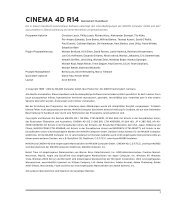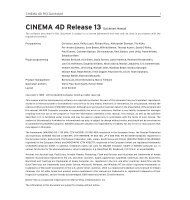Optional module - Maxon Computer
Optional module - Maxon Computer
Optional module - Maxon Computer
Create successful ePaper yourself
Turn your PDF publications into a flip-book with our unique Google optimized e-Paper software.
92 CINEMA 4D R11 Quickstart –BodyPaint 3D<br />
Rotate the view so you can see the eyelid from the top. Activate the “Render Active View for RayBrush Painting“<br />
and the “Enable / Disable Projection Painting“ mode and set the brush size to 10 and hardness to 40. Switch to<br />
the color layer’s “Color” menu and set the color to a medium gray which will be the base color for our eyelid.<br />
Now go to the bump layer’s color preview and set the color to black (both color layers are located at the left<br />
of the Object or Material Manager in the “Material” tab under the letters “F” and “B” + pencil symbol). When<br />
you paint on the object you will notice that both colors are being applied to the object – the gray base color<br />
and the black (to indicate indentations). (If white were the color of the Bump channel it would “raise” the brush<br />
stroke instead of indicating indentations). The result could look like the following image.<br />
Load the “QS_BP3D_Final.c4d” file and take a look at it when you have time. Here are some everyday tips with<br />
which you can achieve great results quickly and easily.<br />
6. Tips & Tricks<br />
A very helpful function can be found in CINEMA 4D’s preferences (Ctrl+E). In the “BodyPaint“ menu you will<br />
find the function “Project On Invisible Parts“. Which, when activated, can make your work a lot easier. Let’s<br />
assume you want to color the arm of a figure or sprinkle color on the entire figure. You would have to apply<br />
the color with this function deactivated, rotate the arm, apply the color, rotate the arm and, well, you get the<br />
idea. When this function is activated you apply the color in the front view and the color is applied to all surfaces<br />
lying behind this surface at the same time. Just make sure you don’t apply color to objects you don’t want to<br />
color when this function has been activated.<br />
If a texture map does not fit correctly at the point where large and small polygons meet (in the case of low-poly<br />
objects that are subordinates of HyperNURBS) set the “Tile UV’s“ function, in the respective HyperNURBS Object’s<br />
Attribute Manager, from “User” to “Border“ or “Edge”. This sends the UV-mesh through the HyperNURBS<br />
algorithm and subdivides it to fit the polygon object.<br />
Avoid UV-mesh polygons that meet to a point when applying a “noise texture“ to a bump layer. The narrower<br />
a 3-sided polygon becomes, the coarser the bump noise channel will be rendered. Of course such a polygon<br />
has much less area for the noise structure at its tip than it does at its center which results in a magnification<br />
effect of the noise structure.<br />
Try to set up each side of a triangulated polygon as an isosceles. This also goes for “4-point polygons“ when they<br />
converge into a trapezoid. The more square the polygon the more even the structure will be. It goes without<br />
saying that you need different brushes for different texture looks. CINEMA 4D has a wide variety of brush types<br />
for you to use. Just select the tab “Attributes“ and click on the small arrow on the brush preview









